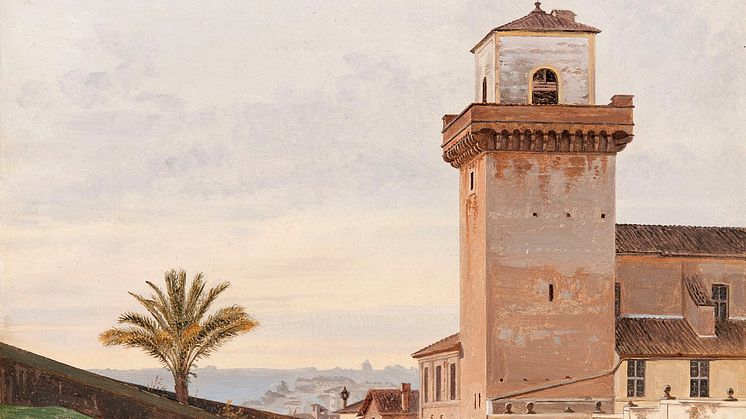
Press release -
New acquisition: View of San Pietro in Vincoli in Rome by Constantin Hansen
Nationalmuseum has expanded its
fine art collection with the acquisition of a view of Rome with the church of
San Pietro in Vincoli in the foreground, painted in 1836 by the Danish artist
Constantin Hansen. In recent decades, oil sketches featuring Italian motifs
have been increasingly sought after by museums and private collectors alike.
Nationalmuseum is therefore especially pleased to have acquired Hansen’s
splendid little Roman scene with the aid of a generous bequest.
This
oil sketch by Constantin Hansen (1804–80) represents a type of painting that
became common in the first half of the 19th century, when artists from northern
Europe visited Rome in large numbers. They stayed for several years, developing
their artistic sense and technical skill. A key part of their education
involved immortalizing views like this in deftly executed oil sketches.
Although many of the motifs were well known to the tourists of the time, the artists
were equally likely to choose an insignificant view. Their primary goal
was to practise depicting light and atmosphere as realistically as possible.
The resulting works were therefore not specifically intended for sale or even
for public display. In these works, the artists did not need to adhere to
convention, but could allow themselves to be subjective in their portrayal. The
motifs are often somewhat insignificant, with a perspective that does not
immediately focus on what is expected. Instead, the motifs seem to be based on
a personal fascination.
A
magical sense of calm hangs over Hansen’s view of the church of San Pietro in
Vincoli, largely because the foreground is completely dominated by a quiet,
deserted square. One possible explanation is that the artist associated the
setting with personal experiences, rather than wishing to document the view as
such. From the foreground, the viewer’s eye is directed down a steep street,
between a walled garden at left and the church at right, to gaze out over the
distant roofs of Rome through a bluish haze. It is easy to imagine how, from
the spot where he was painting, the artist would have felt drawn first to the
mysterious garden behind the walls, then to the cool, dark interior of the
church, and finally to the city beyond, with its infinite number of alleyways
teeming with life.
For
artists such as Constantin Hansen, sketches like this became treasured
souvenirs, which they often kept for the rest of their life. It is conceivable
that these paintings are considered so desirable today because of their fresh,
realistic depictions. The intervening years are quickly blotted out, and
contemporary viewers can easily share the artist’s experience of and
fascination with this Roman scene.
The donor, Mrs
Ulla-Bella Sandberg (1926–2013), was a long-time member of the Friends of
Nationalmuseum and bequeathed her entire estate to the museum. Combined with a
generous donation from director Gunnar Hultmark, this bequest enabled the
purchase of Constantin Hansen’s exquisite view of Rome. Nationalmuseum has no
budget of its own for new acquisitions, but relies on gifting and financial
support from private funds and foundations to enhance its collections of fine
art and craft.
Further information for press
Carl-Johan Olsson,
curator, carl-johan.olsson@nationalmuseum.se, +46 8 5195 4324
Hanna Tottmar, press
officer, hanna.tottmar@nationalmuseum.se, +46 767 23 46 32
Caption
Constantin Hansen, View of San Pietro in Vincoli in
Rome, 1836. Photo: Sofia
Persson/Nationalmuseum.
Categories
Nationalmuseum is Sweden’s premier museum of art and design. The collections comprise older paintings, sculpture, drawings and graphic art, and applied art and design up to the present day. The museum building is currently under renovation and scheduled to open again in 2017. In the meantime, the museum will continue its activities through collaborations, touring exhibitions and a temporary venue at the Royal Swedish Academy of Fine Arts, Fredsgatan 12, Stockholm. Nationalmuseum collaborates with Svenska Dagbladet, Fältman & Malmén and Grand Hôtel Stockholm. For more information visit www.nationalmuseum.se.

